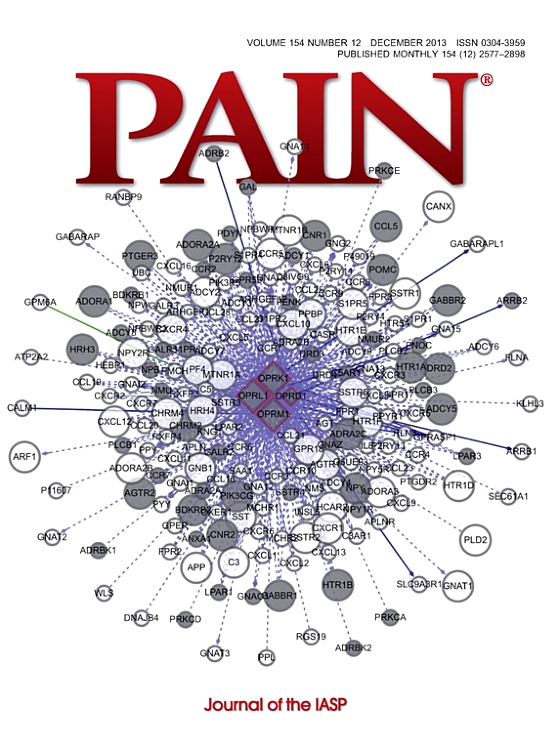促运动素系统和神经胶质细胞作为控制神经炎症和减轻Fabry-Anderson病小鼠模型疼痛的药理学靶点。
IF 5.5
1区 医学
Q1 ANESTHESIOLOGY
引用次数: 0
摘要
神经性疼痛是Fabry-Anderson病(FD)的主要症状。它在儿童时期发展,是终身的,并且抵抗目前的治疗;迫切需要寻找新的治疗策略。我们证明神经炎症控制能有效缓解FD疼痛。我们使用了两种药理学方法:小胶质细胞抑制剂米诺环素和特异性受体拮抗剂PC1阻断趋化因子prokinetin -2的活性(专利化合物1)。采用10周龄和25周龄雄性GLA-/-小鼠(FD小鼠模型)。这些小鼠的特征是机械异常性疼痛、热痛觉过敏、对冷刺激不敏感和腹痛。用二甲胺四环素或PC1治疗两周成功地抵消了感觉改变。FD肠道中存在明显的炎症状态,其特征是高水平的促动素-2和促炎细胞因子。坐骨神经最初表现为严重的神经炎症,随着时间的推移逐渐减轻。在背根神经节中,神经炎症严重且持续存在,原运动素-2、促炎细胞因子、离子钙结合受体分子1和胶质原纤维酸性蛋白过表达;组蛋白去甲基化酶KDM6A和B也上调。我们强调了脊髓的神经炎症随着时间的推移而增加。米诺环素或PC1治疗可显著抵消炎症和神经炎症,降低促运动素-2和促炎细胞因子水平,增加抗炎因子PPARγ表达。这两种治疗方法都防止了脊髓中微胶质细胞和星形胶质细胞的发生。我们强调了神经炎症和小胶质细胞在FD疼痛中的作用,并建议控制促动素系统活性、胶质细胞激活、促炎细胞因子的产生和增加抗炎介质的治疗对FD疼痛有治疗作用。本文章由计算机程序翻译,如有差异,请以英文原文为准。
The prokineticin system and glia cells as pharmacological targets to control neuroinflammation and to relieve pain in a murine model of Fabry-Anderson disease.
Neuropathic pain is a major symptom of Fabry-Anderson disease (FD). It develops in childhood, is life-lasting, and resists current therapies; finding new therapeutic strategies is urgently needed. We demonstrate that neuroinflammation control effectively relieves FD pain. We used 2 pharmacological approaches: the microglial inhibitor minocycline and the block of the activity of the chemokine prokineticin-2 with the specific receptor antagonist PC1 (patented compound 1). Ten- and 25-week-old male GLA-/- mice (the FD murine model) were used. These mice were characterized by mechanical allodynia, thermal hyperalgesia, hyposensitivity to cold stimuli, and abdominal pain. Two weeks of treatment with minocycline or PC1 successfully counteracted sensory alterations. A significant inflammatory state, characterized by high levels of prokineticin-2 and proinflammatory cytokines, was present in the FD gut. The sciatic nerve showed initial severe neuroinflammation that attenuated over time. In dorsal root ganglia, neuroinflammation was severe and persistent with prokineticin-2, proinflammatory cytokines, ionized calcium-binding adapter molecule 1, and glial fibrillary acidic protein overexpression; histone demethylases KDM6A and B were also upregulated. We highlighted neuroinflammation in the spinal cord that increased over time. Treatment with minocycline or PC1 significantly counteracted inflammation and neuroinflammation, reducing prokineticin-2 and proinflammatory cytokines levels and increasing anti-inflammatory factor PPARγ expression. Both treatments prevented the onset of micro- and astrogliosis in the spinal cord. We underline the role of neuroinflammation and microglia in FD pain and suggest that treatments that control the activity of the prokineticin system, glial activation, and the production of proinflammatory cytokines and increase anti-inflammatory mediators have a therapeutic effect on pain in FD.
求助全文
通过发布文献求助,成功后即可免费获取论文全文。
去求助
来源期刊

PAIN®
医学-临床神经学
CiteScore
12.50
自引率
8.10%
发文量
242
审稿时长
9 months
期刊介绍:
PAIN® is the official publication of the International Association for the Study of Pain and publishes original research on the nature,mechanisms and treatment of pain.PAIN® provides a forum for the dissemination of research in the basic and clinical sciences of multidisciplinary interest.
 求助内容:
求助内容: 应助结果提醒方式:
应助结果提醒方式:


